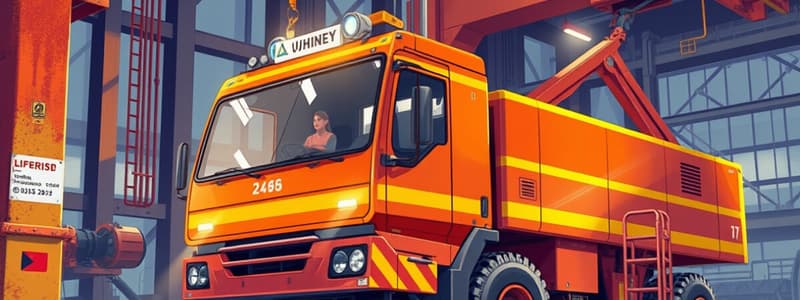Podcast
Questions and Answers
What is the primary purpose of regularly inspecting lifting equipment?
What is the primary purpose of regularly inspecting lifting equipment?
- To ensure the equipment's continued safety (correct)
- To comply with legal requirements
- To determine the equipment's market value
- To verify the manufacturer's specifications
How should lifting accessories be treated according to supply legislation?
How should lifting accessories be treated according to supply legislation?
- As independent from the load they assist in lifting
- As a component part of lifting equipment that requires regular inspection
- As integral parts of the load and subject to inspection regulations (correct)
- As items strictly governed by international lifting equipment standards
Which of the following is NOT a reason for inspecting lifting equipment?
Which of the following is NOT a reason for inspecting lifting equipment?
- To ensure it is functioning correctly
- To familiarize oneself with its features
- To determine operator competency (correct)
- To check for necessary repairs
What should be included in lift planning concerning accessories?
What should be included in lift planning concerning accessories?
In which scenario should lifting accessories be inspected as rigorously as the equipment?
In which scenario should lifting accessories be inspected as rigorously as the equipment?
Why is it critical to supplement the examination of lifting equipment with tests and measurements?
Why is it critical to supplement the examination of lifting equipment with tests and measurements?
What does the examination of lifting equipment primarily aim to achieve?
What does the examination of lifting equipment primarily aim to achieve?
Which aspect should NOT be considered part of the robust inspection regime for lifting accessories?
Which aspect should NOT be considered part of the robust inspection regime for lifting accessories?
What is the primary advantage of using Magnetic Particle Inspection (MPI) over dye penetrant methods?
What is the primary advantage of using Magnetic Particle Inspection (MPI) over dye penetrant methods?
Which materials are compatible with the Eddy Current testing method?
Which materials are compatible with the Eddy Current testing method?
What is a key limitation of Dye Penetrant testing?
What is a key limitation of Dye Penetrant testing?
Which flaw types can Eddy Current testing accurately detect?
Which flaw types can Eddy Current testing accurately detect?
What distinguishes the interpretation of results in Magnetic Particle Inspection (MPI)?
What distinguishes the interpretation of results in Magnetic Particle Inspection (MPI)?
What is the primary difference between SWL and WLL?
What is the primary difference between SWL and WLL?
In some regions, which term is used instead of 'safe' in SWL?
In some regions, which term is used instead of 'safe' in SWL?
Which statement is true regarding the marking of lifting equipment?
Which statement is true regarding the marking of lifting equipment?
Who is responsible for assessing the SWL of lifting equipment?
Who is responsible for assessing the SWL of lifting equipment?
What does the Working Load Limit (WLL) indicate?
What does the Working Load Limit (WLL) indicate?
What type of records should include the SWL of lifting equipment?
What type of records should include the SWL of lifting equipment?
Which aspect does NOT contribute to determining the SWL?
Which aspect does NOT contribute to determining the SWL?
Which of the following is an incorrect statement about lifting accessories?
Which of the following is an incorrect statement about lifting accessories?
For lifting accessories marked with a SWL, what does the abbreviation signify?
For lifting accessories marked with a SWL, what does the abbreviation signify?
Why is it important not to exceed the SWL during operations?
Why is it important not to exceed the SWL during operations?
What is the primary purpose of verification in lifting equipment?
What is the primary purpose of verification in lifting equipment?
Which of the following is NOT included in the verification procedures for lifting equipment?
Which of the following is NOT included in the verification procedures for lifting equipment?
What is the outcome of a thorough examination report if defects are found?
What is the outcome of a thorough examination report if defects are found?
Who is responsible for issuing the report of a thorough examination?
Who is responsible for issuing the report of a thorough examination?
What factor of safety was originally used for grade 40?
What factor of safety was originally used for grade 40?
What must be retained as part of the lifting equipment records?
What must be retained as part of the lifting equipment records?
Which designation indicates that a chain is hardened and tempered?
Which designation indicates that a chain is hardened and tempered?
What additional information may be included in a thorough examination report if testing occurs?
What additional information may be included in a thorough examination report if testing occurs?
Which of the following methods is NOT part of the verification process?
Which of the following methods is NOT part of the verification process?
What is the relationship between breaking strength and heat treatment in the grades discussed?
What is the relationship between breaking strength and heat treatment in the grades discussed?
Why might a reference to a test report appear as an appendix in a thorough examination report?
Why might a reference to a test report appear as an appendix in a thorough examination report?
What was the primary focus of the European standards program initiated in the late 1980s?
What was the primary focus of the European standards program initiated in the late 1980s?
When referring to chain for hoists prior to the 1980s standards, what term was used?
When referring to chain for hoists prior to the 1980s standards, what term was used?
Which of the following statements regarding verification is accurate?
Which of the following statements regarding verification is accurate?
What does the 'Kuplex' term signify in the context of component compatibility?
What does the 'Kuplex' term signify in the context of component compatibility?
What does the term 'Competent Person' refer to in the context of lifting equipment?
What does the term 'Competent Person' refer to in the context of lifting equipment?
What does the designation 'T(8)' represent?
What does the designation 'T(8)' represent?
How is the maximum stress level determined for components not strictly defined by stress levels?
How is the maximum stress level determined for components not strictly defined by stress levels?
What was introduced to distinguish between chains' tolerances during the European standards program?
What was introduced to distinguish between chains' tolerances during the European standards program?
Which grades are now considered interchangeable in terms of use after heat treatment?
Which grades are now considered interchangeable in terms of use after heat treatment?
Study Notes
Importance of Equipment Inspection
- Regular equipment inspection ensures continued safety for another usage period.
- Competency verification of the user is essential to operate equipment correctly.
- Inspection highlights necessary repairs for optimal performance.
- Regular checks confirm correct operation of equipment.
- Safety assurance for users by identifying hazards early.
- Familiarization with equipment benefits operational efficiency and knowledge.
Lifting Equipment Overview
- Lifting equipment includes all types of lifting accessories and appliances.
- Lifting accessories serve to attach loads to lifting appliances.
- Regulations may classify lifting accessories as part of the load, impacting inspection legislation.
- Adequate strength and defect-free condition are crucial for accessories in lifting scenarios.
Verification Process
- Verification ensures lifting equipment meets legal standards and safety requirements.
- Procedures include proof load tests, sample break tests, and non-destructive tests.
- Every verification step is essential for maintaining compliance and operational safety.
Report of Thorough Examination
- A thorough examination report records inspection results, noting any defects.
- The report signifies whether the equipment is fit for continued use.
- Reports must be retained as part of lifting equipment records for accountability.
Safe Working Load (SWL)
- SWL is the maximum load an item can safely lift based on a Competent Person's evaluation.
- SWL is marked on equipment and documented in statutory records.
- Some regions use "specific application load" instead of "safe," but requirements remain the same.
Working Load Limit (WLL)
- WLL defines the maximum intended load a piece of equipment can handle.
- Terms like "maximum SWL" are commonly applied to lifting accessories.
- Factors of safety have evolved, with classifications influencing labeling and usage.
Inspection Methods for Material Integrity
- Dye Penetrant Testing: Efficient for detecting surface cracks and defects in nonporous materials.
- Magnetic Particle Inspection (MPI): Effective for revealing flaws in ferrous materials through magnetic flux leakage.
- Eddy Current Testing: Non-invasive method for identifying surface and subsurface defects but cannot be used on non-conductive materials; offers rapid set-up and no chemical use.
Studying That Suits You
Use AI to generate personalized quizzes and flashcards to suit your learning preferences.
Related Documents
Description
This quiz covers the importance of regular equipment inspection to ensure safety and compliance, specifically for lifting equipment. It highlights the key processes involved in verifying the integrity and functionality of lifting accessories. Understanding these principles is crucial for maintaining operational efficiency and user safety.




